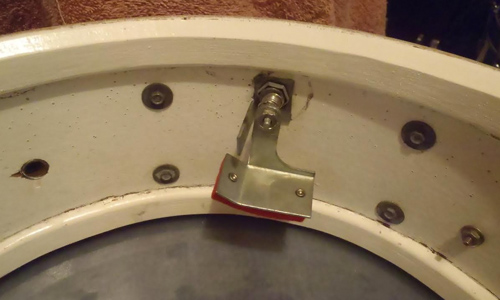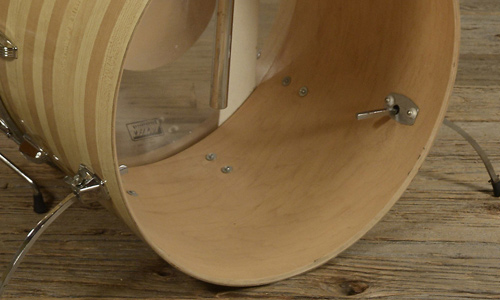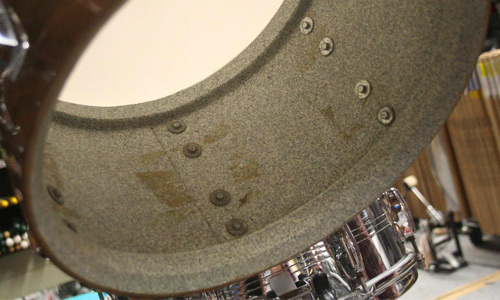Ludwig’s expansive past is nearly as long as the line of drummers eager to get their hands on the company’s legendary vintage gear. However, with so many years of history under its belt, accurately identifying the year of manufacture for a Ludwig drum is a daunting task for those unfamiliar with the company’s evolution.

The lion’s share of vintage Ludwig drums available on the market hail from the company’s golden years of the '60s, '70s, and early '80s. The fifty years from Ludwig’s inception in 1909 to the early 1960s deserves its own article, so in order to give you the most pertinent information for dating, we’ll be looking at drums from the early '60s onwards.
Unlike the many components and changing particulars which make dating a guitar difficult, a few key, consistent elements make identifying a drum’s year of manufacture much easier. In this article, we’ll be looking at the three best ways to identify a Ludwig: date stamp, serial number/badge style and shell construction.
Forenote: The first two means of indication, date stamp and serial number/badge style, are the two most accurate for identifying the correct year of production. Throughout a drum’s life, it may be refinished, re-edged, and re-housed in hardware not from the drum’s era, but the date stamp and serial number will serve as a northern star to correct identification.
The evolution of Ludwig hardware is a detailed and multi-faceted story. For this reason and the aforementioned trend of updating vintage drums, hardware will not be covered in this guide.
Date Stamp
Date stamps are simultaneously the best and worst means to properly date a Ludwig drum from the '60s (use of the date stamp was discontinued ca. 1970 with the introduction of the “Blue & Olive” badge). A drum was stamped when the shell was finished, providing the most accurate depiction of the age of wood due to the fact final assembly came later.
The difficulty in date stamps is, more often than not, that the stamp has been rendered illegible or removed completely due to the wear and tear of the years. However, if you’re lucky enough to come across a particularly clean specimen with the date stamp intact, you’ll know the exact day that drum came to be.
Aside from the exact date printed on the shell, the color of ink used will assist in identifying the era of the drum and indicate the possibility of forgery. From the inception of date-stamping in 1960 through 1963, Ludwig solely used red ink. From 1964 to 1969, both red and black inks were used with black as the predominant color.
Serial Number/Badge Styles
These are the gold standards for identifying a vintage Ludwig drum. The general rule of thumb is a “Keystone” badge indicates a drum from the '60s and a “Blue & Olive” badge indicates a drum from the '70s or early '80s. The Blue & Olive badge replaced the Keystone in 1969, so there’s some natural overlap.

If you find yourself wondering if your Blue & Olive badge might be a ‘69, a quick consultation of the serial number will clear up any uncertainty. In addition, the Keystone badge was reintroduced on certain models in the early '80s.
Whereas the Keystone badge only had two iterations (one from 1960-63 featuring no serial number and an update from 1964-69 with serial number found at the top or bottom of the badge), the Blue & Olive badge went through a number of modifications from its introduction in 1969 through the mid-'80s.

The first B&O badges from 1969-70 continued sequentially from the six-digit Keystone badges, but in 1971 the company incorporated badges with no serial number, referred to as “blanks.” Ludwig re-integrated the serial system in either 1971 or 72, but the leftover blanks were occasionally used throughout the '70s.
Much debate exists on the “pointy” and “rounded” Blue & Olive badges. Pointy badges - those with a pointed edge - are typically associated with models from the earlier '70s.
After receiving a number of complaints that the badges catch on clothing and fabric, Ludwig began rounding off the edges, producing the “rounded” badge. In addition, individual owners may have trimmed the badges themselves, so consulting a serial number will provide a better gauge on the drum.


The “Black & White” badge was introduced with Ludwig’s Rocker series which ran from 1984 through the mid '90s.
These badges also adorned the aluminum Acrolite snare from 1994 to the mid 2000s, when the drum featured a Black Galaxy Sparkle finish. One last thing to bear in mind: a drumset featuring sequential serial numbers tends to be higher in value than sets with era-correct badges and hardware but non-sequential serial numbers.
Keystone
| 1961-62 | N/A |
| 1963 | N/A-7900 |
| 1964 | 9XXX - 33449 |
| 1965 | 108532 - 259XXX |
| 1966 | 260XXX - 449XXX |
| 1967 | 450XXX - 548XXX |
| 1968 | 549XXX-665372 |
| 1969 | 670XXX-741215 |
Blue & Olive
| 1969 | 765XXX - 834XXX |
| 1970 | N/A |
| 1971 | 835XXX - 895XXX |
| 1972 | 896XXX - 916XXX |
| 1976 | 917XXX - 1290XXX |
| 1978 | XXXXXXX |
| 1979 | XXXXXXX - 2013537 |
Shell Construction
If you happen to know your woods, examining the plies and interior finish can be instrumental in era identification, but again, the drum may have been modified through the years. Shells from 1960 through the fall of 1968 were comprised of two mahogany plies with a single poplar ply sandwiched between. The shells were complemented by a 1” reinforcement ring of maple.
From 1961 until 1968 the interiors were painted white. A clear lacquer finish was used in 1960, 1968, 1969, and part of 1970. At that point, Ludwig introduced the Granitone finish, a gritty grey coating used to cover aesthetically displeasing blemishes in the interior wood finish.



From autumn 1968 through 1975, Ludwig changed the mahogany plies over to maple, and in 1976 introduced the Classic series, abandoning the reinforcement rings and opting for six plies of maple and poplar. The Classic drums also opted back to the clear lacquer interior finish.
The Classic series marked Ludwig’s transition into larger volume, frugally-minded production techniques to meet modern demands. The more coveted vintage drums feature the 3-ply construction.
Conclusion
Armed with this information, you now have the tools at hand to begin identifying and dating the Ludwigs of yesteryear. Purchasing a vintage snare or set is a thrilling experience not only for the find, but also for the knowledge that your new instrument persevered through the decades and is now at your fingertips to create anew. Now, get out there and grab a piece of history.
